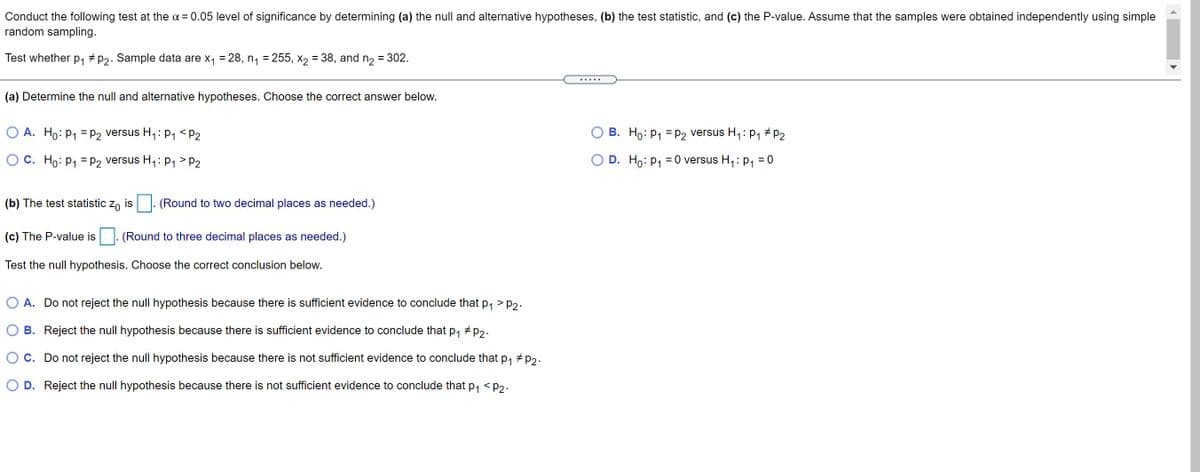Conduct the following test at the a = 0.05 level of significance by determining (a) the null and alternative hypotheses, (b) the test statistic, and (c) the P-value. Assume that the samples were obtained independently using simple random sampling. Test whether p, #P2. Sample data are x, = 28, n, = 255, x2 = 38, and n2 = 302. (a) Determine the null and alternative hypotheses. Choose the correct answer below. O A. Ho: P, = p2 versus H,: p, P2 O D. Ho: P, = 0 versus H,: p, = 0 (b) The test statistic z, is. (Round to two decimal places as needed.) (c) The P-value is (Round to three decimal places as needed.) Test the null hypothesis. Choose the correct conclusion below. O A. Do not reject the null hypothesis because there is sufficient evidence to conclude that P, >P2. O B. Reject the null hypothesis because there sufficient evidence to conclude that p, P2. OC. Do not reject the null hypothesis because there is not sufficient evidence to conclude that p, #p2- O D. Reject the null hypothesis because there is not sufficient evidence to conclude that p, <2
Conduct the following test at the a = 0.05 level of significance by determining (a) the null and alternative hypotheses, (b) the test statistic, and (c) the P-value. Assume that the samples were obtained independently using simple random sampling. Test whether p, #P2. Sample data are x, = 28, n, = 255, x2 = 38, and n2 = 302. (a) Determine the null and alternative hypotheses. Choose the correct answer below. O A. Ho: P, = p2 versus H,: p, P2 O D. Ho: P, = 0 versus H,: p, = 0 (b) The test statistic z, is. (Round to two decimal places as needed.) (c) The P-value is (Round to three decimal places as needed.) Test the null hypothesis. Choose the correct conclusion below. O A. Do not reject the null hypothesis because there is sufficient evidence to conclude that P, >P2. O B. Reject the null hypothesis because there sufficient evidence to conclude that p, P2. OC. Do not reject the null hypothesis because there is not sufficient evidence to conclude that p, #p2- O D. Reject the null hypothesis because there is not sufficient evidence to conclude that p, <2
College Algebra (MindTap Course List)
12th Edition
ISBN:9781305652231
Author:R. David Gustafson, Jeff Hughes
Publisher:R. David Gustafson, Jeff Hughes
Chapter8: Sequences, Series, And Probability
Section8.7: Probability
Problem 58E: What is meant by the sample space of an experiment?
Related questions
Question
help with hw

Transcribed Image Text:Conduct the following test at the a = 0.05 level of significance by determining (a) the null and alternative hypotheses, (b) the test statistic, and (c) the P-value. Assume that the samples were obtained independently using simple
random sampling.
Test whether p, + P2. Sample data are x, = 28, n, = 255, x2 = 38, and n2 = 302.
%3D
... ..
(a) Determine the null and alternative hypotheses. Choose the correct answer below.
O A. Ho: P1 = P2 versus H,: P1 <P2
B. Ho: P1 = P2 versus H,: p1 # P2
C. Ho: P1 = p2 versus H,: p1 > P2
O D. Ho: P1
= 0 versus H,: P, = 0
(b) The test statistic z, is . (Round to two decimal places as needed.)
(c) The P-value is . (Round to three decimal places as needed.)
Test the null hypothesis. Choose the correct conclusion below.
O A. Do not reject the null hypothesis because there is sufficient evidence to conclude that p, > p2.
B. Reject the null hypothesis because there is sufficient evidence to conclude that p, + p2.
C. Do not reject the null hypothesis because there is not sufficient evidence to conclude that p, # p2.
D. Reject the null hypothesis because there is not sufficient evidence to conclude that p, <p2.
Expert Solution
This question has been solved!
Explore an expertly crafted, step-by-step solution for a thorough understanding of key concepts.
Step by step
Solved in 5 steps with 5 images

Recommended textbooks for you

College Algebra (MindTap Course List)
Algebra
ISBN:
9781305652231
Author:
R. David Gustafson, Jeff Hughes
Publisher:
Cengage Learning

College Algebra (MindTap Course List)
Algebra
ISBN:
9781305652231
Author:
R. David Gustafson, Jeff Hughes
Publisher:
Cengage Learning